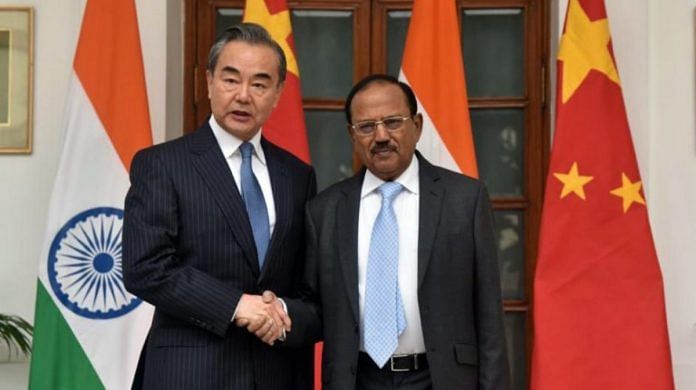New Delhi: National Security Advisor Ajit Doval held an emergency meeting with Chinese State Councillor and Minister of Foreign Affairs Wang Yi, and agreed on “earliest complete disengagement of the troops along the LAC and de-escalation from India-China border areas for full restoration of peace and tranquility”.
India and China have also decided to disengage in a “phased” and “step-wise” manner — the first sign of de-escalation of the two-month border standoff.
Doval and Wang held the discussions over the phone late Sunday evening under the mechanism of Special Representatives (SR) of India and China on the Boundary Question, also called the SR talks. Doval is the SR for India, while Wang is his Chinese counterpart.
Both sides had a “frank and in-depth exchange of views” on the recent developments in the Western Sector of the India-China border areas, the Ministry of External Affairs (MEA) said in a statement Monday.
Both the SRs also discussed the Galwan Valley clash that led to the killing of 20 Indian soldiers, while the condition of many still remained critical, sources told ThePrint.
“They (India and China SRs) agreed that it was necessary to ensure at the earliest complete disengagement of the troops along the LAC and de-escalation from India-China border areas for full restoration of peace and tranquillity. In this regard, they further agreed that both sides should complete the ongoing disengagement process along the LAC expeditiously. The two sides should also ensure a phased and step-wise deescalation in the India-China border areas,” the statement read.
The sources said the Chinese side has gone “a few steps” back in the Galwan Valley and Pangong Lake area.
During the talks, they added, both the SRs spoke “based on the commitment” reached by Prime Minister Narendra Modi and Chinese President Xi Jinping at the two informal summits of Wuhan (2018) and Mamallapurm (2019) when both leaders vowed that differences should not be allowed to become disputes.
“They re-affirmed that both sides should strictly respect and observe the Line of Actual Control and should not take any unilateral action to alter the status quo and work together to avoid any incident in the future that could disturb peace and tranquillity in border areas,” the MEA said.
The last round of SR talks took place in December last year.
The two special representatives also agreed both sides “should take guidance from the consensus of the leaders that maintenance of peace and tranquility in the India-China border areas was essential for the further development of our bilateral relations and that two sides should not allow differences to become disputes”, the statement said.
Meanwhile, the Chinese Foreign Ministry said in a statement Monday: “There is progress made on frontline troops taking effective measures to disengage and ease tensions.”
This comes after both sides conducted a third round of talks on 30 June at the commanders’ level.
Also read: From Nathu La to Galwan, India has been trapped in reaction-mode to China’s aggression
‘Premature’ to say that standoff is over
Sources also told ThePrint both sides vowed to adhere to the agreements that lay down the specific protocols since 1993, which are aimed at border management and maintaining peace and tranquility.
The pacts are the 1993 Agreement on Maintenance of Peace and Tranquility along the Line of Actual Control in the India-China Border Areas, the 1996 Agreement on Confidence Building Measures in the Military Field along the LAC, the 2005 Protocol on Modalities for the Implementation of the Confidence Building Measures in the Military Field along the LAC, the 2012 Agreement on the Establishment of a Working Mechanism for Consultation and Coordination on India-China Border Affairs, and 2013 Border Defence Cooperation Agreement.
The sources, however, said it will be “premature” to say the standoff is over as “any unfavourable” incident like that of 15 June night can take place until “tempers on both sides cool down completely”, and that the leadership on both sides will continue to remain in contact 24×7.
The SRs came to the conclusion that both will continue with the regular contact between military and diplomatic levels, including under the framework of the Working Mechanism for Consultation and Coordination on India-China border affairs (WMCC), the sources added.
The WMCC was last held on 24 June between Naveen Srivastava, Joint Secretary (East Asia), and Wu Jianghao, Director General of the Department of Boundary & Oceanic Affairs, Chinese Ministry of Foreign Affairs, when both sides agreed to “expeditiously” resolve the standoff in Eastern Ladakh.
The disengagement process is believed to have been initiated in the Galwan Valley, Hot Spring and Gogra Post area of Eastern Ladakh, but there has not been any tangible movement in the Pangong Lake area.
According to the sources, the Chinese troops were “seen removing tents and structures” where the standoff had taken place even as “rearward movement of vehicles of PLA seen at General area Galwan, Hotsprings and Gogra”.
Also read: As India, China face off again, late Brig Dalvi’s memoir on 1962 reminder of what went wrong



